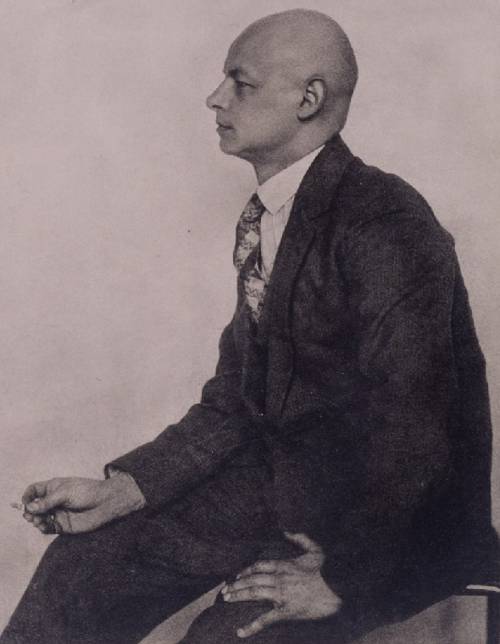
FAQ About Oskar Schlemmer

Who was Oskar Schlemmer?
Oskar Schlemmer was a notable German artist associated with the Bauhaus movement, which was a revolutionary approach to art and design in the early 20th century. He was renowned for his work in various artistic disciplines, including painting, sculpture, and choreography. Schlemmer is particularly famous for his innovative performance art piece known as 'The Triadic Ballet,' which incorporated avant-garde choreography and costuming.

What is 'The Triadic Ballet'?
'The Triadic Ballet' is a performance art piece by Oskar Schlemmer that premiered in 1922. It is considered a seminal work in modern dance and is celebrated for its use of geometric costuming, which abstracted the human form. The ballet consists of three acts, each characterized by different moods conveyed through innovative choreography, costumes, and music, emphasizing the relationships between space, form, and movement.

What role did Oskar Schlemmer play in the Bauhaus movement?
Oskar Schlemmer played a pivotal role in the Bauhaus movement as both an instructor and an innovator. At the Bauhaus school, he led the stage workshop, where he encouraged students to explore the intersections between art, architecture, and performance. His work often examined the relationship between the body and space, which was a key theme in Bauhaus experimentation.

How did Oskar Schlemmer influence modern dance?
Oskar Schlemmer significantly influenced modern dance by introducing the concept of integrating visual arts with dance. His work, especially through 'The Triadic Ballet,' emphasized the abstraction of the human form and the theatrical experience of space and geometry, which inspired future generations of dancers and choreographers to explore similar interdisciplinary approaches.

What are some characteristics of Oskar Schlemmer's art style?
Oskar Schlemmer's art style is characterized by a focus on abstraction, geometry, and the human form. He often used simple geometric shapes in his paintings and designs, striving to create harmony between human figures and their surrounding spaces. His work reflects the Bauhaus ideals of combining functionality with artistic expression.

Where did Oskar Schlemmer study and work?
Oskar Schlemmer began his education at the Kunstgewerbeschule in Stuttgart and later studied at the Akademie der Bildenden Künste in Stuttgart. He became a prominent figure at the Bauhaus school in Weimar and Dessau, where he worked and taught during the 1920s. His role at the Bauhaus significantly shaped both his career and the direction of modern art and design education.

What is the significance of geometry in Schlemmer's work?
Geometry plays a central role in Oskar Schlemmer's work, particularly in his approach to visualizing the human body and its interaction with space. His use of geometric forms aimed to create an ordered, harmonious aesthetic that reflected the Bauhaus principles of unifying fine art and functional design. This emphasis on geometry helped establish a new visual language in modern art and performance.

What mediums did Oskar Schlemmer use in his artwork?
Oskar Schlemmer was a versatile artist who worked across a variety of mediums, including painting, sculpture, costume design, and choreography. His interdisciplinary approach was integral to his exploration of themes such as the human form, movement, and space, which he expressed through both two-dimensional and three-dimensional works.

How does Oskar Schlemmer's work relate to the Bauhaus philosophy?
Oskar Schlemmer's work reflects the core philosophy of the Bauhaus movement, which sought to dissolve boundaries between fine and applied arts by integrating various art forms into cohesive aesthetic and functional designs. His exploration of the human figure in motion, spatial dynamics, and the use of geometric forms all resonate with the Bauhaus objective to harmonize art and technology in the modern world.

What impact did Schlemmer have on choreography and performance art?
Oskar Schlemmer had a lasting impact on choreography and performance art through his revolutionary use of costume and set designs that transformed the way the human body was perceived on stage. His integration of mechanical and geometric elements into dance challenged traditional forms, paving the way for new interpretations of body movement and theatrical presentation in the 20th century.

Did Oskar Schlemmer work with other famous Bauhaus artists?
Yes, Oskar Schlemmer worked alongside other famous Bauhaus artists such as Walter Gropius, Paul Klee, and Wassily Kandinsky. These collaborations and exchanges of ideas were instrumental in shaping the distinctive style and interdisciplinary nature of the Bauhaus movement. Schlemmer's contributions were particularly influential in the integration of visual arts with stage performance.

What themes did Oskar Schlemmer explore in his paintings and sculptures?
Oskar Schlemmer's paintings and sculptures often explored themes of human form, spatial dynamics, and abstraction. He was interested in depicting figures in a way that emphasized their relationship to the surrounding space, using geometric forms to create a sense of order and balance. His work frequently aimed to reflect the harmony between geometry, movement, and functionality.

How did World War II affect Oskar Schlemmer's career?
World War II had a significant impact on Oskar Schlemmer's career, as many of his works and the modernist ideals of the Bauhaus were considered degenerate by the Nazi regime. This led to a period of professional isolation and constraint. Despite these challenges, Schlemmer continued to create art privately, focusing on themes that remained true to his artistic vision.

Are there any major exhibitions showcasing Oskar Schlemmer's work today?
Major exhibitions of Oskar Schlemmer's work continue to be held internationally, often within the context of exploring the Bauhaus movement. Museums and galleries that focus on modern art and design frequently feature Schlemmer's works to highlight his contributions to art and performance. One such example was the Bauhaus centennial exhibitions that celebrated his legacy alongside fellow Bauhaus contemporaries.

What is a notable quote by Oskar Schlemmer?
A notable quote by Oskar Schlemmer reflects his dedication to the integration of art and life: "Art is the link connecting human labor with the spiritual realm." This statement underscores Schlemmer's belief in the transformative power of art to bridge the functional and the visionary.

How is Oskar Schlemmer's legacy preserved today?
Oskar Schlemmer's legacy is preserved through continued scholarly research, exhibitions, and the documentation of his work in art history. Institutions focusing on modern art, design, and the Bauhaus movement frequently revisit Schlemmer's contributions, ensuring his impact on art and performance is remembered and studied by new generations. Publications and archives dedicated to Bauhaus history also play a crucial role in maintaining his legacy.

What inspired Oskar Schlemmer's distinctive style?
Oskar Schlemmer's distinctive style was inspired by a combination of classical art training, the burgeoning avant-garde movements of his time, and his involvement with the Bauhaus philosophy that emphasized the unity of art, design, and function. His fascination with geometry, human anatomy, and the relationship between movement and space contributed significantly to the development of his unique artistic vision.

Did Schlemmer's work influence any specific art movements?
Oskar Schlemmer's work influenced several art movements, particularly those aligned with modernism and interdisciplinary practices. His integration of visual arts and choreography prefigured developments in performance art, as well as concepts explored by later movements such as minimalism and abstract expressionism. His legacy can be seen in the ongoing interest in merging disciplines to create holistic artistic experiences.

What challenges did Schlemmer face during his artistic career?
Throughout his career, Oskar Schlemmer faced numerous challenges, including political and artistic suppression during the rise of the Nazi regime, which branded his modernist work as degenerate. Additionally, maintaining his avant-garde ideals in a world shifting towards conservative tastes required resilience and dedication to his artistic vision. Despite these challenges, Schlemmer continued to innovate in his private works and teachings.

What are some famous works by Oskar Schlemmer besides 'The Triadic Ballet'?
Besides 'The Triadic Ballet,' Oskar Schlemmer is also well-known for his paintings such as 'Bauhaus Stairway' and 'The Dancer.' These works exemplify his exploration of geometry and the human form. Schlemmer's wall paintings and murals, created during his time with the Bauhaus, also highlight his significant role in integrating art into architectural spaces.
